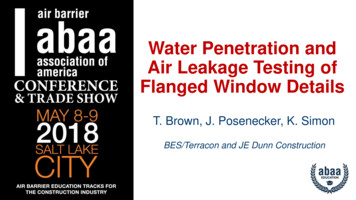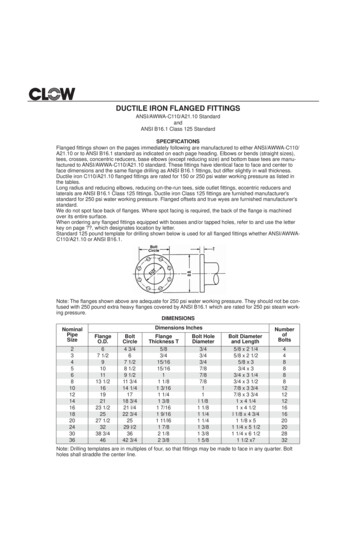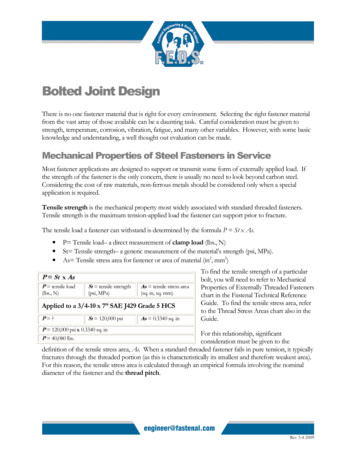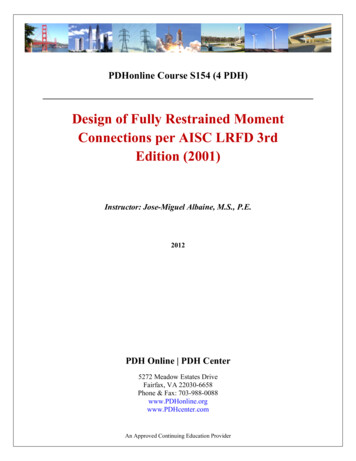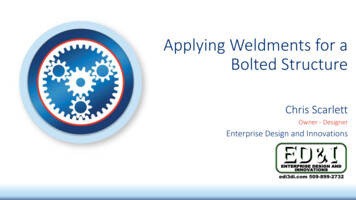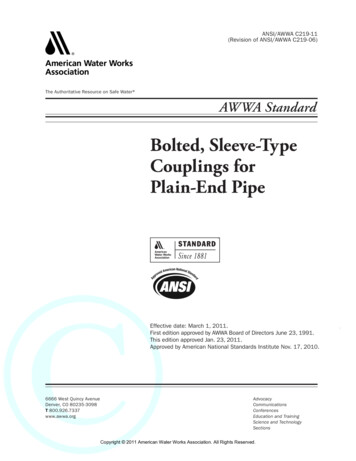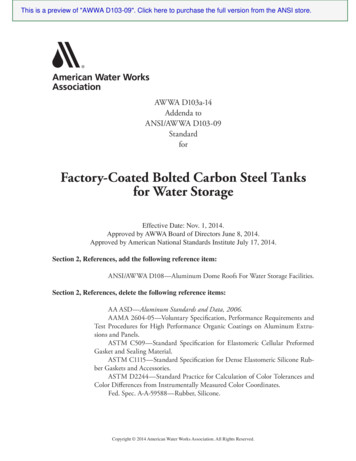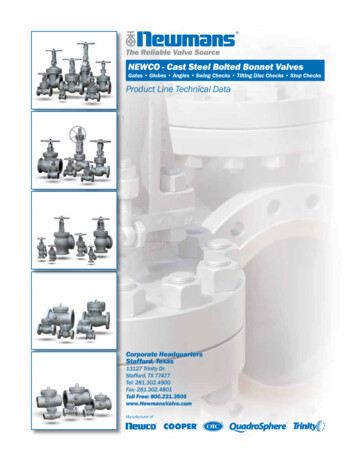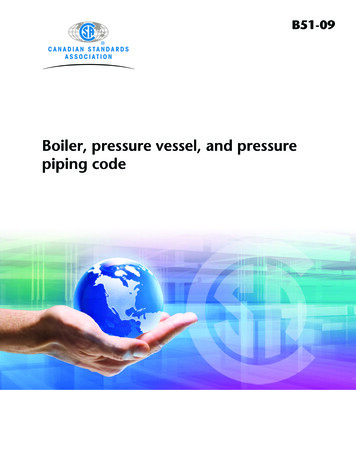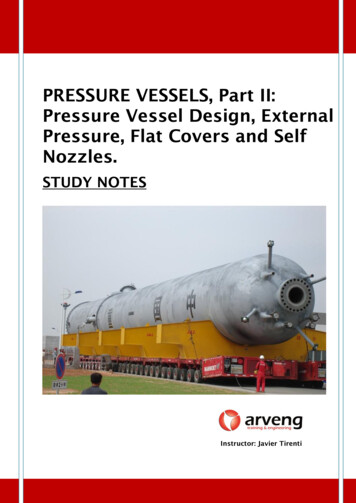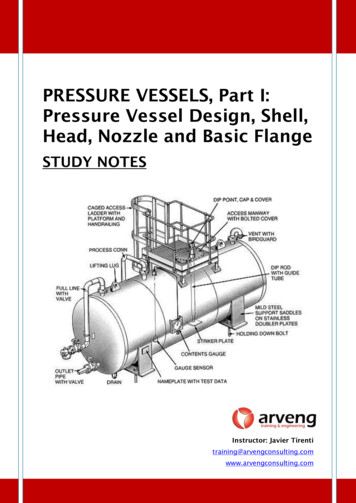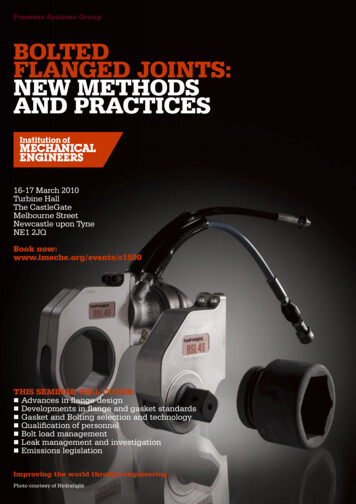
Transcription
Pressure Systems GroupBoltedFlanged Joints:New Methodsand Practices16-17 March 2010Turbine HallThe CastleGateMelbourne StreetNewcastle upon TyneNE1 2JQBook now:www.imeche.org/events/s1500THIS SEMINAR WILL COVER: Advances in flange design Developments in flange and gasket standards Gasket and Bolting selection and technology Qualification of personnel Bolt load management Leak management and investigation Emissions legislationImproving the world through engineeringPhoto courtesy of Hydratight
Bolted Flanged Joints:New Methods and PracticesThe seminar will highlight some of the new methods and practices associated with thedesign, selection, assembly and maintenance of bolted flanged joints in pressure systems. Itwill provide information on developments in gasket technology and the changes in EN 1591code for flange design.Important issues in the assembly of bolted joints and the main methods of controlledtightening will be addressed. Common errors in both assembly and tightening will behighlighted, and advice given on how these can be avoided.Case studies and discussion sessions will be included on operations issues and maintenance,including emissions legislation, leak management, investigation and record keeping.Who should attend?Benefits of attendance: Engineers Learn about the latest advances in Europeanwith an interest in pressure systems Specialistsinvolved in onshore and offshore pipelines Usersand operators of pressure equipmentwhich incorporates bolted flanged jointsand American technology from renownedinternational experts Examine Thoseinvolved in health and safety and environmentalissues relating to pressure equipment Engineersworking in process, petrochemical,power generation, oil and gas, including designers,inspection engineers and managers“”developments in standards,gasket materials, bolt tighteningtechnology and the qualification ofpersonnel competency Studythe failure mechanisms for boltedflanged joints Appreciate the problems associated with themanagement of the integrity of bolted joints Increaseawareness of the requirements ofemissions legislation, leak managementand investigation and record managementYet anotherwell-roundedseminar.Thank you.Peter Batty,LmPSpeaking about:Pressure SystemsFailure Seminar,March 2009 Avoidproblems caused by selection ofinappropriate flange type, gasket materialor bolting Adopta good-practice management systemfor bolted joints Improvethe training and competency ofpersonnelPhoto courtesy of HydratightSponsorship and ExhibitionOpportunitiesYour involvement with our events is an effective way to get into theminds of key decision makers, helping you capture your chosenaudience when they are in the frame of mind to do business.Our flexible opportunities allow you to:Supportingorganisationsn Showcase new productsn Raise awareness of your operationn Improve perception of your brandn Influence other organisations’spending plansTo talk through how to get the best fromone of our events,contact Aman DuggalTel: 44 (0)20 7973 1309Email: sponsorship@imeche.org
Bolted Flanged Joints: New Methods and Practices16-17 March 2010The CastleGate. Melbourne Street, Newcastle upon TyneDay 1Selection and Design09:30 Registration and Refreshments10:00 Chairman’s Welcome and Introduction10:10 IntroductionRobert Noble, Technical Services Leader, Hydratight Comparison of the Bolted Joint with the Welded Joint The Bolted Joint in the Pressure Equipment Directive Changing Standards and guidelines around the bolted JointSelection:10:35 Flange SelectionDr David Nash, Reader & Vice Dean, University of StrathclydeSimon Earland, Director, Earland Engineering Standard flanges (EN 1092, EN 1759, ASME B16.5 and B16.47) Proprietary flanges (Taper-Lok, Grayloc, Verax, etc.) Custom designed flanges Quick release openings11:00 Q&A Session11:20 Refreshments11:50 Gasket SelectionDr Gavin Smith, Technical Director, Novus Sealing Limited A gasket is a relatively low cost item but it is critical to the safeoperation of any plant. If it leaks, there is a loss of containment andcontainment is critical to plant operation To ensure safe operation, a gasket must be: Correctly selected, Ofthe right quality and properly assembled The presentation will discuss each of these areas in turn and providepractical guidance on achieving a leak free bolted connection12:15 Bolt SelectionRod Corbett, Managing Director, James Walker Rotabolt The physical and metallurgical properties of key metals/alloyingelements and their impact on bolt alloy selection Material selection for bolt strength; comparison with relevant boltstandards Material selection for high temperature, cryogenic and corrosionresistance applications; medium carbon low alloy steels versus nonferrous alloys Selection criteria for resistance to environmental embrittlementsuch as stress corrosion cracking, hydrogen and liquid metal. The impact of bolt alloy selection on the effectiveness of the bolttightening process12:40 Q&A Session13:00 LunchDesign:14:00 Traditional Flange Design MethodsWarren Brown, Principal Engineer, The Equity Engineering Group Comparison between the traditional ASME method of flange designand other options Shortcomings the ASME design method Upcoming ASME design revisions Off-Code Improvements to the ASME design method Design versus Assembly and Operation: closing the gap14:25 Overview of Developments in EN 1591Manfred Schaaf, AMTEC Services GmbH EN 1591-1:2001 A1:2009 Design rules for gasketed circular flangeconnections EN 1591-2:2008 Gasket parameters DD CEN/TS 1591-3:2007 Calculation method for metal to metalcontact type flanged joints DD CEN/TS 1591-4:2007 Qualification of personnel competency inthe assembly of bolted joints EN 1591 worked examples14:50 Q&A Session15:10 Refreshments15:40 Failure Mechanisms of Bolted Joints- Bolting AspectsMr Bill Eccles, Technical Specialist, Bolt Science Limited Causes and effects of insufficient bolt preload: Tightening issues,lubrication of bolts, stress relaxation and gasket creep Joint movement and the self-loosening of threaded fasteners Tensile fracture/overload of bolts Fatigue failure of bolts Causes of thread stripping- Flange failure from the Gasket viewpointRuss Currie, Applications Engineering Manager, Flexitallic Failure mechanisms Examples of failures with regard tonon metallic,semi metallic, andmetallic components16:10 European Emissions LegislationDr Brian Ellis, Secretary General, European Sealing Association Development of European environmental legislation Types of legislation Key items of European and national legislation Integrated Pollution Prevention and Control Directive Latest developments16:25 Discussion Session – Day 116:50 Chairman’s Closing Statement17:00 Evening Reception and Exhibition18:00 Close of Day 1
Day 2Assembly and Operation09:30 Registration and Refreshments09:55 Chairman’s WelcomeAssembly of Bolted Joints:10:00 Bolt Tightening Methods and Bolt LoadMeasurementTony Scrivens, Global Engineering Manager, HydratightRod Corbett, Managing Director, James Walker RotaboltBolted Joint Reliability – the three factors The importance of bolt tension/joint compression/gasket seating stress Integrity of the stress strain relationship theory versus practiceand the factors that effect bolt load measurement integrity andsubsequent methodology Design aspects of bolt load measurement for assured reliability anddurability in industrial environments Bolt load measurement using air gap technology; a brief overview ofthe technique and its usageAdditional Speaker TBC10:45 Management of the Integrity of BoltedJoints for Pressurised SystemsRobert Noble, Technical Services Leader, HydratightThe Essential Elements of a Management System Ownership Technology and Practice Criticality Assessment Training and Competence Records, Data Management and Tagging In Service Inspection Management of Leaks Analysis Learning and Improvement11:10 Q&A Session11:30 Refreshments12:00 ASME PCC-1Warren Brown, Principal Engineer, The Equity Engineering GroupOutline of the major changes coming out in ASME PCC-1:2009 “Guidelinesfor Pressure Boundary Bolted Flange Joint Assembly”, including: Appendix A: Training, Qualification and Certification of JointAssembly Personnel Appendix D: Guidelines for Allowable Gasket Contact SurfaceFlatness and Defect Depth Appendix E: Flange Joint Alignment Guidelines Appendix F: Alternative Flange Bolt Assembly Patterns Appendix M: Hardened Washer Usage Guideline and PurchaseSpecification Appendix N: Reuse of Bolts Appendix O: Assembly Bolt Load Selection Appendix P: Guidance on Troubleshooting Flanged Joint LeakageIncidents12:25 Qualification of Personnel Competency –DD CEN/TS 1591-4John Hoyes, Technical Director Emeritus, Flexitallic Ltd Why is Standardisation Necessary Off Shore Precedent Evolution of a CEN Standard Interaction with the Pressure Equipment Directive Upgrading of TS 1591 Part 4 to a full EN standardphoto courtesy of Graham Hart (Process Technology) LtdPressure Systems GroupOrganising Committee:Mr Simon Earland, Earland Engineering (Chairman)Dr David Nash, University of StrathclydeMr Christopher Tudor, HydratightThe committee would like to thank thefollowing supporters:Process Division12:45 Q&A Session13:00 LunchOperation:14:00 A Regulatory perspective on bolted jointsat high hazard sitesIain Paterson, Team Leader Mechanical Engineering,HSE Offshore Division Relevant legislation covering leaks from flanges at high hazard sites A discussion about the EI / Oil & Gas UK guidelines on themanagement of bolted joints Data from HSE’s Hydrocarbon Release Database to show theproportion of leaks from flanged joints and their causes14:15 Leak Management and InvestigationEd Versluis, Sales Manager for Holland - Flange ManagementJW Group, James Walker Rotabolt Reliability parameters for bolted joints Bolted joint behaviour under thermal cycling Heat exchanger leaks - how to avoid?14:40 Q&A Session15:00 Refreshments15:30 Case studiesInvited Contributions16:00 Discussion Session – Day 216:15 Chairman’s Closing Statement16:30 Event ClosesThis programme is subject to amendment.
forwardthinking.If you are interested in any of these events, please contact Jacqui Parker on 44 (0)20 7304 6966 or psg@imeche.org13 May 2010: 1 Birdcage WalkWhen Things Go Wrong What Happens Next?The intent of this event is to enable delegates to understandthe effect and perspective of a serious pressure incident onthose involved, the events and investigation that would followthe incident and lead to a trial, and how the Pressure SystemsSafety Regulations interact with other health and safety law.The seminar will enable owners/users of pressure systems tounderstand the application of the Pressure Systems SafetyRegulations 2000, in the context of the Provision and Use of WorkEquipment Regulations 1998, the Health & Safety at Work etc Act1974 and English Statute & Common Law. The technical benefitsmay be explained in the context of the developments in personaland corporate liability.www.imeche.org/events/s150120 October 2010: 1 Birdcage WalkRBI and Non-Invasive MonitoringBy attending this seminar, delegates will gain an understanding ofgood and best practice in the process of risk-based inspection andnon-invasive monitoring. The effectiveness of the RBI approachagainst more formal methods of inspection will be presented.www.imeche.org/events/s150329 June 2010: 1 Birdcage WalkAdvanced Plant Design and AssessmentMethodsAttend this event to hear about recent advances in design-byanalysis (DBA) methods for the design and assessment of bothconventional and nuclear plant to ASME, BS and EN codes.Come and understand what new skills/software are neededto apply these methods and how DBA can reduce fabricationcosts and increase plant life. Hear what both practitioners andregulators think about these methods. This event will appeal toengineers designing, procuring and assessing vessels and is anopportunity to see the current state of the art.www.imeche.org/events/s150225 November 2010: AberdeenOffshore Pipelines: Life Management and FitnessMany UK subsea pipelines are many years old and need to bejustified for future operation. They can be vulnerable to corrosion,fatigue and mechanical damage from shipping and seabedmovement, but some are difficult to inspect, being very long andin deep water. This event will cover topics relevant to integritymanagement and operation of offshore dibleProfessional Engineering Publishing Ltd is a worldleading provider of journals, magazines, electronicproducts and conference proceedings.Professional registration with us is an internationallyrecognised benchmark of quality.It opens up avenues of opportunity you never knewexisted. New paths, new perspectives; new projects,new partnerships.If you are in the business ofresearch, design, development,manufacturing, installation,contracting or teaching, wehave a level of membershipfor you.To find out more,drop us a line atmembership@imeche.orgor Tel: 44 (0)20 7090 1078August 2004 Vol 217 No E3Institution of MechanicalEngineers members enjoysignificant discounts.Journal of Process Mechanical EngineeringYou may be interested in: Professional Engineer The Engineer Energy World SHP Practitioner Health & Safety Professional JOURNAL OFProceedings of the IMechE Part EprocessmechanicalengineeringProceedings of the Institution of Mechanical EngineersPart EAugust 2008Vol 217 No E3ISSN 0954-4089To find out more head for:www.pepublishing.comThe Institution of MechanicalEngineers is the professionalbody representing over 80,000mechanical engineers worldwide.As a Learned Society, theInstitution seeks to be a sourceof considered, balanced andimpartial informationInstitution ofMechanical EngineersOne Birdcage WalkWestminsterLondonSW1H 9JJT 44 (0)20 7222 7899www.imeche.orgOur Manufacturing ExcellenceAwards recognise emi
Standard flanges (en 1092, en 1759, ASme b16.5 and b16.47) proprietary flanges (Taper-lok, grayloc, Verax, etc.) custom designed flanges Quick release openings 11:00 Q&A SESSION 11:20 REFRESHMENTS 11:50 GASkET SELECTION Dr gavin Smith, technical Director, novus Sealing Limited A gasket is a relatively low cost item but it is critical to the safe
